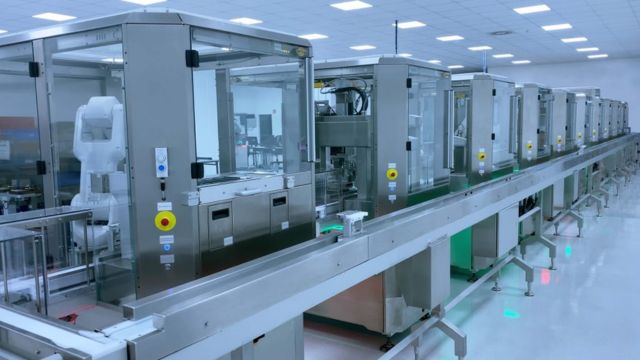Automation and robots have become essential in the fast changing medical production sector in promoting efficiency, accuracy, and quality. Manufacturers are turning to innovative technologies more and more as the worldwide demand for medical devices, supplies, and equipment rises to meet strict regulatory criteria, lower prices, and hasten manufacturing schedules. The advantages of automation and robots as well as the difficulties they aid to address are discussed in this paper together with how they are changing modern medical manufacturing.
Understanding Automation and Robotics in Medical Manufacturing
Automation refers to the use of control systems, such as computers or robots, to perform manufacturing tasks with minimal human intervention. Robotics involves programmable machines capable of carrying out complex tasks such as assembly, inspection, packaging, and material handling.
In medical manufacturing, these technologies span a wide range of applications, including:
-
Precision assembly of medical devices like catheters, pacemakers, and surgical instruments.
-
Automated inspection and quality control using machine vision and sensors.
-
Sterile packaging of consumables such as syringes, gloves, and surgical drapes.
-
Material handling and logistics within cleanroom environments.
-
Data collection and monitoring for compliance with regulatory standards.
Key Benefits of Automation and Robotics in Medical Manufacturing

1. Enhanced Precision and Consistency
To guarantee patient safety and regulatory compliance, medical equipment and supplies must be most precisely and consistently accurate. By perfect accuracy, robotics systems can complete repetitious jobs, hence reducing variability associated with hand labour. Robotic arms, for instance, may precisely assemble small pacemaker components at micron-level level, hence boosting product dependability and lowering faults.
2. Increased Production Speed and Scalability
Operating constantly without tiredness, automation greatly speeds up production processes. Higher throughput and quick production scaling to meet market demand follow from this; these are absolutely vital during pandemics when medical supplies are desperately needed. Running 24/7 with no downtime, automated lines enable companies maximise output and cut lead times.
3. Improved Quality Control and Traceability
Real-time part and completed product inspection is made possible by integrated robotics mixed with machine vision technologies. Early in the production line, automated quality checks find flaws, therefore lowering waste and recall risk. Furthermore, automated systems can record data at every level of production, guaranteeing traceability for audits of regulations like ISO 13485 and FDA 21 CFR Part 820.
4. Safer and Cleaner Manufacturing Environments
Many medical production techniques call for sterile, regulated conditions to avoid contamination. Automation lessens human interaction with delicate products, therefore minimising the danger of infection and contamination. Strict environmental controls maintained by robots running inside cleanrooms help to facilitate aseptic manufacture needed for devices including injectable goods and implants.
5. Cost Reduction and Resource Optimization
Although the initial investment in automation and robotics can be significant, the long-term savings are substantial. Automation reduces labor costs, minimizes errors and rework, and optimizes raw material usage. By streamlining operations, manufacturers achieve better resource management and increase overall profitability.
Applications of Robotics in Medical Manufacturing
Assembly and Fabrication
Robotic systems excel at assembling intricate medical devices that involve small components and complex geometries. For instance, assembling catheters, stents, and surgical tools requires precision beyond human capability. Robotics ensures consistent quality while speeding up production.
Packaging and Labeling
Automation in packaging guarantees sterile and tamper-evident sealing of products. Robotic arms can handle delicate items, place them accurately in packaging, and apply labels with barcodes and batch numbers for traceability. Automated packaging lines reduce human error and contamination risk.
Inspection and Testing
Machine vision integrated with robotics inspects each product for dimensional accuracy, surface defects, and assembly correctness. Automated testing stations perform functional tests to verify device performance before shipment. This enhances quality assurance and compliance with regulatory requirements.
Material Handling and Logistics
Automated guided vehicles (AGVs) and robotic conveyors transport raw materials and finished goods within manufacturing facilities. This improves workflow efficiency and reduces manual labor, especially in large-scale production plants.
Challenges and Considerations
Despite the many benefits, integrating automation and robotics in medical manufacturing comes with challenges:
-
High Initial Investment: Equipment, software, and facility upgrades require significant capital.
-
Complex Validation and Compliance: Automated systems must be rigorously validated to meet regulatory standards.
-
Workforce Training: Employees need specialized training to operate and maintain advanced machinery.
-
System Integration: Ensuring compatibility between different automated systems and legacy equipment can be complex.
Manufacturers must plan carefully, balancing technological advancement with regulatory compliance and workforce readiness.
The Future of Automation and Robotics in Medical Manufacturing
The future of medical manufacturing will see deeper integration of Artificial Intelligence (AI) and Internet of Things (IoT) with robotics. AI-powered robots will adapt to production variabilities in real-time, improving flexibility and reducing downtime. IoT sensors will enable predictive maintenance, minimizing equipment failures and ensuring continuous operation.
Moreover, advances in additive manufacturing (3D printing) combined with robotics will allow for on-demand production of custom medical devices tailored to individual patients, revolutionizing personalized medicine.
Conclusion
Automation and robotics are no longer optional but essential in modern medical manufacturing. They enhance precision, efficiency, and compliance while ensuring patient safety and product quality. By embracing these technologies, manufacturers can meet growing healthcare demands, reduce costs, and stay competitive in a highly regulated industry.
For companies in medical manufacturing, investing in automation is investing in the future of healthcare — one that is smarter, faster, and safer.
At jandjsupplies.com, we provide top-quality medical, clinical engineering, and manufacturing supplies tailored to your needs. Visit jandjsupplies.com today to browse our products or get in touch for expert support and personalized solutions!








